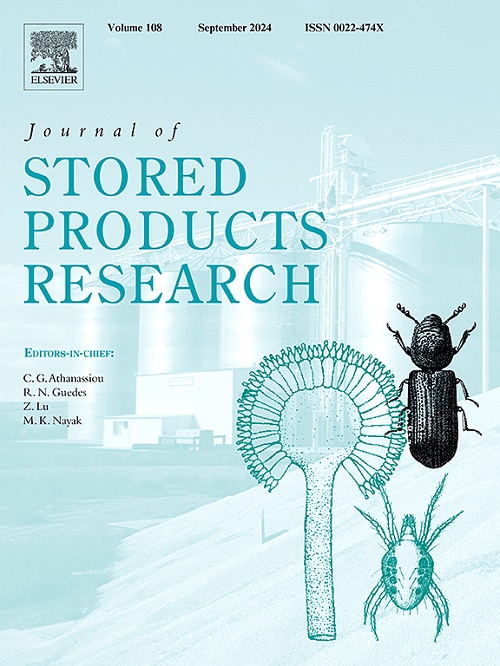Enhancing agronomic traits of finger millet (Eleusine coracana (L.) gaertn) through seed nano-priming using silicon dioxide nanoparticles (SiO2NPs)
IF 2.7
2区 农林科学
Q1 ENTOMOLOGY
引用次数: 0
Abstract
The current study conducted usage of seed nano-priming using silicon dioxide nanoparticles (SiO2NPs) to assess its impact on the morphological and yield parameters, along with biochemical attributes of Eleusine coracana (L.) Gaertn. Seeds were primed with different concentrations of SiO2NPs (25, 50, 75, 100, and 125 mg L−1) for 10 h, with respect to the untreated control. The morphological parameters were observed at tillering, ear head, and harvest stages, and at harvest stage in control plants the shoot length was 81.1 ± 1.4 cm with 12.5 ± 0.4 number of leaves. Nano-priming increased these parameters, and maximum shoot length (99.5 ± 1.1 cm) and number of leaves (14.8 ± 0.5) were recorded for plant nano-primed with 100 mg L−1 SiO2NPs. Similarly, yield parameters like number of fingers/spike (8.2 ± 0.4), length of fingers (spikelets)/spike (15.5 ± 0.7 cm), grain yield/plant (8.5 ± 0.2 g), and straw weight/plant (15 ± 0.3 g) were also significantly higher in plant nano-primed with 100 mg L−1 SiO2NPs in comparison to control plant. Estimating the pigment contents suggested that the contents were higher in reproductive stage than vegetative stage plants for both control and nano-primed plants. The chlorophyll a (360.48 ± 4.59 μg g−1 FW), chlorophyll b (277.60 ± 3.32 μg g−1 FW), total chlorophyll (638.08 ± 2.83 μg g−1 FW), and carotenoid (184.31 ± 2.78 μg g−1 FW) contents were lowest in control plant. Their amounts were significantly increased after nano-priming with 100 mg L−1 SiO2NPs except chlorophyll b which was higher at 125 mg L−1 SiO2NPs, and it was as follows: chlorophyll a (535.05 ± 8.29 μg g−1 FW), chlorophyll b (376.31 ± 5.70 μg g−1 FW), total chlorophyll (897.55 ± 1.51 μg g−1 FW), and carotenoid (279.47 ± 2.75 μg g−1 FW). Similar trend was recorded for antioxidant enzyme activities where the activities of superoxide dismutase (SOD, 23.92 ± 0.60 U g−1 FW), catalase (CAT, 47.91 ± 1.56 U g−1 FW), and guaiacol peroxidase (GPX, 5.49 ± 0.03 U g−1 FW) were highest in reproductive stage plant primed with 100 mg L−1 SiO2NPs. Present study confirmed the role of SiO2NPs on growth and biochemical responses in E. coracana, and also the better growth of plants can be correlated with the increased pigment contents and activities of antioxidant enzymes. This study suggests the use of SiO2NPs as growth enhancer at moderate concentration, and it can be considered an effective strategy for enhancing the production of this crop and emphasizing the need for its careful usage for agricultural purposes.
二氧化硅纳米颗粒(SiO2NPs)对小谷子(Eleusine coracana (L.) gaertn)农艺性状的影响
本研究使用二氧化硅纳米粒子(SiO2NPs)进行种子纳米处理,以评估其对 Eleusine coracana (L.) Gaertn.的形态和产量参数以及生化属性的影响。与未处理的对照组相比,用不同浓度的 SiO2NPs(25、50、75、100 和 125 mg L-1)浸种 10 小时。对分蘖期、穗头期和收获期的形态参数进行了观察,在收获期,对照植株的芽长为(81.1 ± 1.4)厘米,叶片数为(12.5 ± 0.4)片。使用 100 mg L-1 SiO2NPs 纳米填料的植株的芽长(99.5 ± 1.1 厘米)和叶片数(14.8 ± 0.5)最大。同样,与对照植株相比,使用 100 mg L-1 SiO2NPs 纳米填料的植株的产量参数,如指数/穗(8.2 ± 0.4)、指长(小穗)/穗(15.5 ± 0.7 厘米)、谷粒产量/株(8.5 ± 0.2 克)和稻草重量/株(15 ± 0.3 克)也显著增加。对色素含量的估算表明,无论是对照植物还是纳米催肥植物,生殖期植物的色素含量均高于营养期植物。对照植株的叶绿素 a(360.48 ± 4.59 μg g-1 FW)、叶绿素 b(277.60 ± 3.32 μg g-1 FW)、总叶绿素(638.08 ± 2.83 μg g-1 FW)和类胡萝卜素(184.31 ± 2.78 μg g-1 FW)含量最低。使用 100 mg L-1 SiO2NPs 进行纳米催化后,除叶绿素 b 在 125 mg L-1 SiO2NPs 条件下含量较高外,其余含量均明显增加,具体如下:叶绿素 a(535.05 ± 8.29 μg g-1 FW)、叶绿素 b(376.31 ± 5.70 μg g-1 FW)、总叶绿素(897.55 ± 1.51 μg g-1 FW)和类胡萝卜素(279.47 ± 2.75 μg g-1 FW)。抗氧化酶活性也有类似趋势,在使用 100 mg L-1 SiO2NPs 的生殖期植物中,超氧化物歧化酶(SOD,23.92 ± 0.60 U g-1 FW)、过氧化氢酶(CAT,47.91 ± 1.56 U g-1 FW)和愈创木酚过氧化物酶(GPX,5.49 ± 0.03 U g-1 FW)的活性最高。本研究证实了 SiO2NPs 对 E. coracana 的生长和生化反应的作用,而且植株的良好生长也与色素含量和抗氧化酶活性的增加有关。这项研究表明,在中等浓度下使用 SiO2NPs 作为生长促进剂,可被视为提高该作物产量的有效策略,并强调了在农业用途中谨慎使用 SiO2NPs 的必要性。
本文章由计算机程序翻译,如有差异,请以英文原文为准。
求助全文
约1分钟内获得全文
求助全文
来源期刊
CiteScore
5.70
自引率
18.50%
发文量
112
审稿时长
45 days
期刊介绍:
The Journal of Stored Products Research provides an international medium for the publication of both reviews and original results from laboratory and field studies on the preservation and safety of stored products, notably food stocks, covering storage-related problems from the producer through the supply chain to the consumer. Stored products are characterised by having relatively low moisture content and include raw and semi-processed foods, animal feedstuffs, and a range of other durable items, including materials such as clothing or museum artefacts.

 求助内容:
求助内容: 应助结果提醒方式:
应助结果提醒方式:


